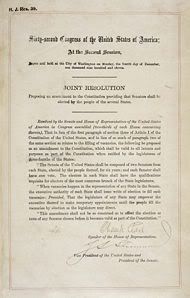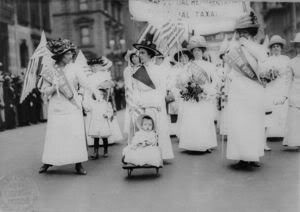(2 pm. – promoted by ek hornbeck)
Burning the Midnight Oil for Progressive Populism
 The “Progressive Era” was not so named because it was an era in which Great Progress was automatic, or effortless. It was so named because it was an era where Income Inequality was high, even by US historical standards, and extraordinarily high by the standard of the Great American Middle Class Era of the 1940’s to 1970’s …
The “Progressive Era” was not so named because it was an era in which Great Progress was automatic, or effortless. It was so named because it was an era where Income Inequality was high, even by US historical standards, and extraordinarily high by the standard of the Great American Middle Class Era of the 1940’s to 1970’s …
… and that meant that winning Progress that went against the vested interests was very hard, and required long, determined fights against a torrent of money deployed to oppose its progress.
Indeed, one of the fruits of the Progressive Era victories was to eliminate Progressivism as a distinct political force. But now the enemies of the Square Deal, New Deal and Great Society have rebuilt a Gilded Age, and we need it once more.
Progressivism, however, while necessary, is not sufficient on its own.
Just some rambling thoughts dashed off before going off to do some tutoring to squeeze an extra hour out of my tremendous underemployment.
Remembering How To Be A Progressive Movement
 Remember that the Square Deal constituted a Deal in which specific long standing Progressive reform policies were championed by the Republican Roosevelt, to woo the Progressives to support the Republican ticket.
Remember that the Square Deal constituted a Deal in which specific long standing Progressive reform policies were championed by the Republican Roosevelt, to woo the Progressives to support the Republican ticket.
Remember that the New Deal constituted a a Deal in which specific long standing Progressive reform policies were championed by the Democratic Roosevelt, to woo the Progressives to support the Democratic ticket.
However, it is hard to remember those things, since most of our memories are formed from the Great American Middle Class and New Gilded Age eras.
The first Gilded Age was built on decades of escalating income inequality. The Long Depression of the 1870’s and 1880’s was not, after all, fundamentally a business cycle depression. It was a price depression, in an era when a large fraction of the population lived on the land, raised much of their subsistence, and relied on market sale to generate the rest. In that situation, unemployment is not the risk: there is always work that can be found to do on a farm. The risk was that the work that was available would not pay enough to meet working farm families’ needs.
That was the age of the railroadification of the United States, and that depression in price through the establishment of large, national competitive market for farmers went hand in hand with the establishment of national non-competitive markets for those industrialists who could create and sustain protected market positions ~ Rockefeller’s Standard Oil of Cleveland was only one of the great “trusts” made possible by freight rail knitting the country into a national market.
Economies of scale meant that many moderates scale producers were driven out of business by a few, large scale producers. Prices dropped, and in the process incomes were concentrated.
And of course working conditions often became worse. As workforces grew in scale, the benefit of squeezing a a bit of extra profit per day per worker was multiplied by hundreds or thousands of workers per day rather than a handful per firm. The great Strikes were provoked by workers largely accustomed to being treated badly, but in no way accustomed to being treated as cruelly as they were in places like the Steel Mills of Pittsburgh.
It was in that context of a squeeze on the former market town middle class and tremendous concentration of wealth that a small concentrated aristocracy of wealth were in the strongest possible position to strategically block reforms that threatened their vested interests. And of course, this meant that a middle class consensus that a reform was the right thing to do was not the last step in the fight for a reform, but only the first step. Once consensus was achieved in a sufficiently broad section of the population, it was then necessary to begin the political fight against the great industrial barons who opposed it.
It was in this context that Progressivism as a distinct political movement arose. Take enough distinct political movements with support by broad sectors of middle class society, frustrated in their aims by the great industrial barons, and a natural strategy for distinct movements with substantial overlap in their support is to band together to fight for a platform of change.
Indeed, it was the Great Compression of the late 1930’s and early 1940’s, won in part as a result of Progressive contributions to the New Deal coalition, that led to the Great American Middle Class. That in turned eliminated Progressivism as a distinctive political force, since a middle class consensus on things that needed to be done was such a strong force that they were largely achieved, and the political contest focused on issues where middle class civil society was more sharply divided: segregation, the war on poverty, war & peace.
Is this thing on? {thunk} {thunk} {thunk}
Time and again we see “poll numbers say that a large majority of Americans agree…”. And yet, issue after issue, progress on those fronts is frustrated.
Witness the assumptions of the Great American Middle Class era on how things work, in the context of the New Gilded Age.
When that happens, it is pretty much automatic that there is some vested interest in the current high aristocracy of wealth that is threatened by progress on that issue. We are once again in an age where a broad consensus in middle class civil society is not the beginning of the political endgame, but merely the end of the political opening plays.
Fortunately, we have broad history to guide us. Progressivism alone will not be enough. There will always be a range of views in middle class civil society from radical reactionary to conservative to progressive to radical progressive, and in a Gilded Age, there will always be the means to both foster the conservative and reactionary tendencies, as well as to amplify those who are won over.
And just as with the Square Deal and New Deal, Progressivism itself is focused on a middle class that is not as large in a Gilded Age as we were used to it being in the age of the Great American Middle Class era. We might pretend that the middle three fifths of the population are the “middle income classes” … but part of the income inequality is also a squeezing down of ability of people short of the middle rung of the income ladder to “afford” a middle class standard of living.
So we need to do more than to build a strong, healthy, Progressive movement. We also need to build a full throated, unbashed, economic populist movement. Economic populism will play a big role during the economic turmoil that accompanies the end of the Age of Oil. Indeed, we have already seen the aristocracy of wealth promote and amplify a reactionary populism, built on lies and fantasies about how the economy works.
We need to build an economic populism based on the real world:
- Customers are the Job Creators ~ Owners try to create as few jobs as they can get away with
- The government can damn well print as much money as they want to
- Social Security is People Working Today paying our Mothers and Fathers and Grandmothers and Grandfather’s Retirement Today, and we are damn well entitled to having our retirement paid in turn.
The list, of course, goes on.
As does the fight: the floor is open for discussion.

2 comments
Author
Least of all our current Republican President.
The Dems who don’t or won’t, need to be fired. I don’t care who they’re replaced by. I’d rather see it coming than be stabbed in the back.